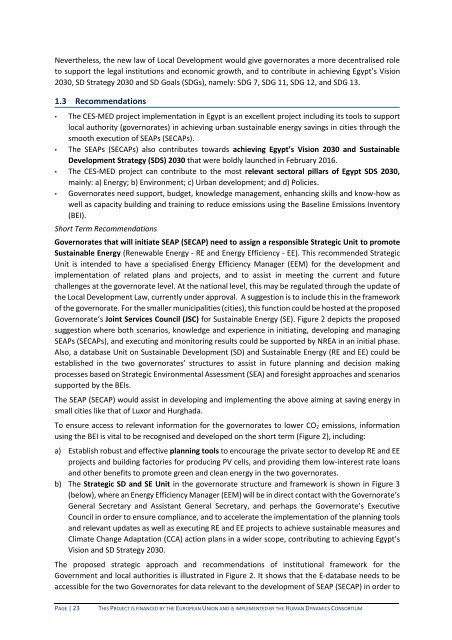180917_CES-MED_National_Report_Egypt_FINAL2rev
Create successful ePaper yourself
Turn your PDF publications into a flip-book with our unique Google optimized e-Paper software.
Nevertheless, the new law of Local Development would give governorates a more decentralised role<br />
to support the legal institutions and economic growth, and to contribute in achieving <strong>Egypt</strong>’s Vision<br />
2030, SD Strategy 2030 and SD Goals (SDGs), namely: SDG 7, SDG 11, SDG 12, and SDG 13.<br />
1.3 Recommendations<br />
• The <strong>CES</strong>‐<strong>MED</strong> project implementation in <strong>Egypt</strong> is an excellent project including its tools to support<br />
local authority (governorates) in achieving urban sustainable energy savings in cities through the<br />
smooth execution of SEAPs (SECAPs).<br />
• The SEAPs (SECAPs) also contributes towards achieving <strong>Egypt</strong>’s Vision 2030 and Sustainable<br />
Development Strategy (SDS) 2030 that were boldly launched in February 2016.<br />
• The <strong>CES</strong>-<strong>MED</strong> project can contribute to the most relevant sectoral pillars of <strong>Egypt</strong> SDS 2030,<br />
mainly: a) Energy; b) Environment; c) Urban development; and d) Policies.<br />
• Governorates need support, budget, knowledge management, enhancing skills and know-how as<br />
well as capacity building and training to reduce emissions using the Baseline Emissions Inventory<br />
(BEI).<br />
Short Term Recommendations<br />
Governorates that will initiate SEAP (SECAP) need to assign a responsible Strategic Unit to promote<br />
Sustainable Energy (Renewable Energy - RE and Energy Efficiency - EE). This recommended Strategic<br />
Unit is intended to have a specialised Energy Efficiency Manager (EEM) for the development and<br />
implementation of related plans and projects, and to assist in meeting the current and future<br />
challenges at the governorate level. At the national level, this may be regulated through the update of<br />
the Local Development Law, currently under approval. A suggestion is to include this in the framework<br />
of the governorate. For the smaller municipalities (cities), this function could be hosted at the proposed<br />
Governorate’s Joint Services Council (JSC) for Sustainable Energy (SE). Figure 2 depicts the proposed<br />
suggestion where both scenarios, knowledge and experience in initiating, developing and managing<br />
SEAPs (SECAPs), and executing and monitoring results could be supported by NREA in an initial phase.<br />
Also, a database Unit on Sustainable Development (SD) and Sustainable Energy (RE and EE) could be<br />
established in the two governorates’ structures to assist in future planning and decision making<br />
processes based on Strategic Environmental Assessment (SEA) and foresight approaches and scenarios<br />
supported by the BEIs.<br />
The SEAP (SECAP) would assist in developing and implementing the above aiming at saving energy in<br />
small cities like that of Luxor and Hurghada.<br />
To ensure access to relevant information for the governorates to lower CO 2 emissions, information<br />
using the BEI is vital to be recognised and developed on the short term (Figure 2), including:<br />
a) Establish robust and effective planning tools to encourage the private sector to develop RE and EE<br />
projects and building factories for producing PV cells, and providing them low-interest rate loans<br />
and other benefits to promote green and clean energy in the two governorates.<br />
b) The Strategic SD and SE Unit in the governorate structure and framework is shown in Figure 3<br />
(below), where an Energy Efficiency Manager (EEM) will be in direct contact with the Governorate’s<br />
General Secretary and Assistant General Secretary, and perhaps the Governorate’s Executive<br />
Council in order to ensure compliance, and to accelerate the implementation of the planning tools<br />
and relevant updates as well as executing RE and EE projects to achieve sustainable measures and<br />
Climate Change Adaptation (CCA) action plans in a wider scope, contributing to achieving <strong>Egypt</strong>’s<br />
Vision and SD Strategy 2030.<br />
The proposed strategic approach and recommendations of institutional framework for the<br />
Government and local authorities is illustrated in Figure 2. It shows that the E‐database needs to be<br />
accessible for the two Governorates for data relevant to the development of SEAP (SECAP) in order to<br />
PAGE | 23<br />
THIS PROJECT IS FINANCED BY THE EUROPEAN UNION AND IS IMPLEMENTED BY THE HUMAN DYNAMICS CONSORTIUM

















